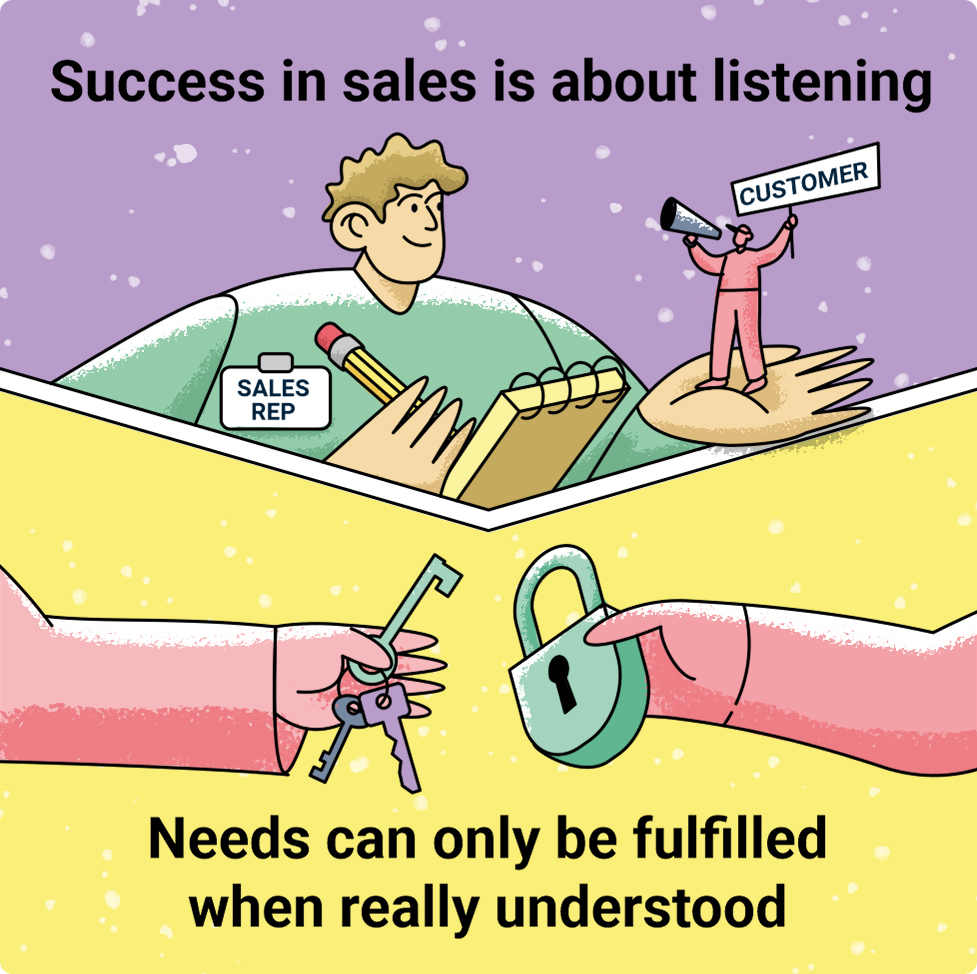Salespeople are the backbone of any sales-oriented company.
They represent the brand to customers, create value, and persuade prospects to choose your company over your competitors. They also have the responsibility for generating revenues and finding new customers while maintaining healthy relationships with older ones, all in order to ensure your business’s success.
But what makes a good salesperson, and how can you attract the right talent to join your team?
What sales qualities should they possess? Is it all about charisma, discipline, and strategic planning? How to determine they are good at sales?
Let’s find out!
Outline:
Building a successful sales team
A great salesperson is not just someone with the right qualifications but also one who will help make your company prosperous. Besides, hiring a high-quality sales employee means less turnover and greater productivity for you!
Successful companies have a diverse sales team. They know how to mix and match different skill sets and personality types for the best possible result.
Of course, it’s paramount that, when considering hiring new sales reps, you should compare their skills and weigh all the pros and cons to determine whether or not they’ll make an excellent fit for your team and company.
These are some things that are bound to improve if you have a high-performing sales team:
- Increased revenue: If you want to boost revenue, then the best way is by having top sales reps. Salespeople motivate and inspire their clients so that they can see how great your products or services are and what benefits they can reap.
- Improved reputation: Good communication and service are crucial when converting a prospect into a paying customer. It’s important to create a positive impression on leads, which helps build a stellar business reputation you can benefit from in the long run!
- Strong relationships: People are more likely to buy from you again when they trust your company. Great salespeople know this secret and develop a relationship with their clients so that all prospects become loyal, repeat customers in no time.

11 Best Recruitment Automation Software For 2026
December 23 2025
Are best salespeople introverts or extroverts?

A potential top-performing salesperson needs to have a certain personality type, right?
It’s widely believed that the best sales representatives are extroverts. Such people know how to make you feel comfortable with their friendly and easy-going attitude. Not only can they find a common ground, but they can also sell anything! Talkative, sociable, and action-oriented — sounds like any company’s dream.
Hiring managers will often try to spot extroverts when looking for new sales employees. But don’t be in a rush! An extroverted personality type can be easily distracted and enjoy center stage a bit too much — which means they’re not good listeners.
On the other hand, introverts are deep thinkers with better memory and an attention span that lasts longer than most people’s. They know how to listen, are better at planning, and have a problem-solving superpower.

So, how do you know which is more suited?
The answer is neither. There are no extroverts or introverts that make the best salesperson.
Instead, look for an ambivert personality type — someone with traits of both personalities who can be friendly and open-minded while listening to your client’s needs without judgment.
And since the type of personality a person has can be misleading when hiring a sales rep, the best way is by focusing on what qualities they have, regardless of their extroversion and introversion traits.
Qualities to look for in salespeople
Now let’s take a look at the top 13 qualities you should seek out when looking for a new salesperson.
Responsible and disciplined
Responsible salespeople are disciplined no matter what. At work, they have their thoughts with clients and stick to the schedule while not wasting time on anything else. Besides, good salespeople are always ready for a call or meeting. They don’t look through materials minutes before the start of one but are prepared in advance.
Such professionals don’t stop even after the deal is closed. Responsible sales reps keep working with the client, keeping them engaged and happy, and building customer loyalty.
Another thing that helps them succeed at selling is recognizing their mistakes and being upfront about them instead of blaming other people or throwing themselves under the bus, as some might do in a similar situation.
Good listener
One of the most effective selling strategies is to listen to the customer. This way, you can connect with them and show them that you understand their pain points, concerns, and needs. Your potential clients will see you as someone they can trust and someone who can help them achieve their goals.
It really works! When you approach customers as a credible advisor, they stop defending themselves and stop focusing on the thought that you’re trying to sell them something. And when prospects are relaxed, they will usually start discussing the actual issues at hand and be open to providing you with needed information.

Focused on value
In the past, salespeople might have just assumed their product would sell due to its potential and the fact that everyone was a prospect. Nowadays, though, sellers know it’s vital to focus on the potential client and make sure the company’s solution is of any value before even thinking about conversion.
The best salespeople understand that not every person is actually a customer. They can tell who their potential clients are and who won’t buy from them. And they know there’s nothing wrong with recommending other solutions or brands if the prospect is looking for another type of product or service they can’t offer.
Focused on customer
This sales quality is closely connected with the ability to listen we’ve discussed above.
To create a product that meets the customer’s needs both now and in the future, salespeople should be able to customize it. And to do this effectively, they need an understanding of their clientele by listening closely to what issues they face and what goals they would like to achieve.
Listening to customers and asking the right questions will help sales reps provide a tailored experience. Good sales professionals lay out how to position their company or product as a solution to their prospects’ problems and identify what is needed to keep them happy.
If sales reps jump into selling without considering what clients need, they will likely run away.

Up-to-date with the latest trends
To sell products or services in the best way possible, a salesperson must take time and do some research before starting any sales conversation with customers.
With so many resources available online, being up-to-date with the latest sales trends is not a need — it’s a must. Social media posts, sales books, journals, and other publications, news — salespeople can utilize every source and tool at hand more efficiently than ever before.
Eager to learn
The most successful salespeople are not just knowledgeable but also able to read their clients and know how to tailor their pitches. They stay on top of trends to be prepared for any situation that may arise during a sale. They never stop learning new skills or honing themselves as professionals because they know: there’s always room for improvement.
Sales reps need to learn new tactics to promote their product through different means and channels such as ads, brochures, flyers, emails — Duocircle can help you out with the latter.
Trustworthy
Successful salespeople need more than just charisma and communication skills — they need to build trust.
A professional who can maintain and strengthen customer relationships through all sales funnel stages must be 100% honest, transparent, authentic, and have the ability to identify their client’s problem by questioning them in ways that are creative enough for a solution they will like.
Just knowing your product or service is not going to work because understanding how it solves potential customers’ problems is essential.
Passionate about selling
A good salesperson has a passion for what they are selling and is strongly connected with what their company stands for. If you don’t believe in what you’re selling, no one else will either!
Clients can instantly tell if you’re passionate about what your company offers because customer service skills will speak out loud. They would rather purchase a product from an organization that actually believes in its products than one run by people who only care about making money.

Good with the latest technology
It’s essential to understand the newest technology, but it’s just as important how you can use it. Understanding and implementing trends like mobile optimization or sales automation will help your business run more effectively.
Social-media-savvy consumers who know exactly what they want from their purchase experience without needing an endless list of options will pass on the offer if they feel their needs are not catered to at the moment. They’ll move onto another company quicker than ever if there isn’t enough personalization involved during every step of their buyer journey.
So, make sure you use proper technology to make conversion smooth (Snov.io is one of the tools that can help you with that!).
Charismatic
The salesperson that is always charismatic will attract attention and make people stop to listen. They must be able to turn the person’s breath away from their product. A top-tier sales rep knows how important charisma can be when selling something new in order for them to get noticed before someone else does.
Optimistic
Optimistic salespeople are much more successful than pessimists. It’s not just the smile on their face that makes them optimistic, it’s also how they approach a prospect and what words come out of their mouth when talking to someone who might be interested in buying one of your products or services.
Persistence is a crucial sales quality, as rejection and objections should be expected. An optimistic individual will use their intelligence and polite persistence to save a situation instead of giving up or becoming discouraged by it.
Speaking of…
Excellent negotiator
Successful salespeople know how to negotiate a price.
They’ll deal with clients who want different services, bargain on not just the project cost but also the scope, and try adding unneeded features into contracts. If done incorrectly, negotiations can turn unreasonable with skimpy profit margins and a prospect unwilling to budge from their stance, potentially compromising your business goals.

Good improviser
One of the most important skills in sales is improvisation.
It can be used when you’re trying to close a deal, or it can help with other aspects such as communication and negotiation. After all, we are constantly adapting and improving our sales techniques, so why shouldn’t we tweak our presentation style, too?
Some sales professionals may not agree on this point, but there will always be situations where an improv approach might work better than others!
Besides, sales reps must be able to improvise and come up with creative solutions when faced with unexpected questions from clients. This ability not only shows their confidence but also proves how well-versed they are in the industry’s latest trends!
Wrapping up
Sales is a tough business.
You need people who are driven, passionate, and committed to the company’s values. They should be able to think on their feet without getting flustered by difficult questions.
Salespeople also need to find the balance between being charismatic and listening. The key is to ask open-ended questions that allow customers to share their problems, challenges, and goals without getting distracted by the product features. This will make them feel more at ease, talking freely about themselves, so they can provide better input for you going forward.
When you find someone with these qualities, it will pay off dividends down the road as they continue building relationships with your clients.
What other traits do you value when looking for great sales professionals? If you would like us to add something to the list, share your preferred sales qualities in the comments.





